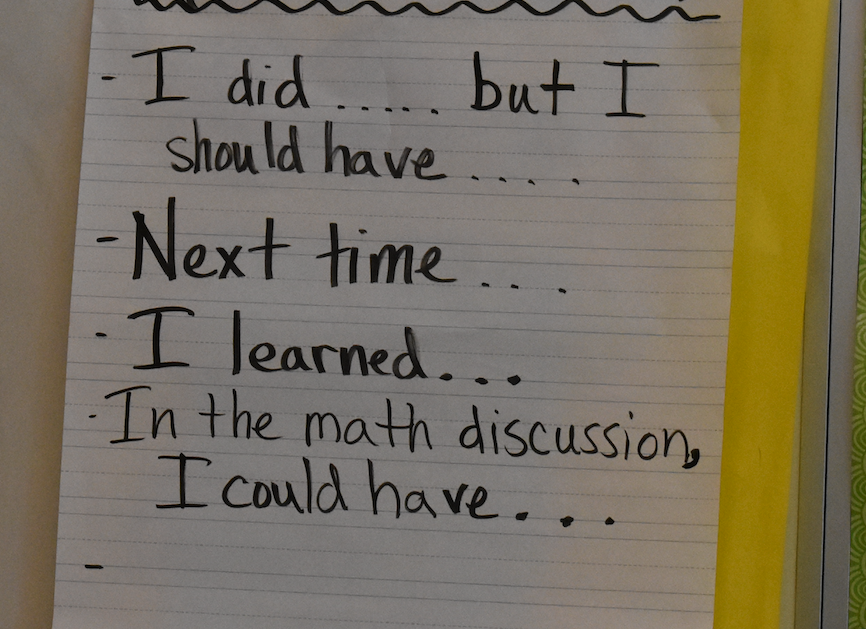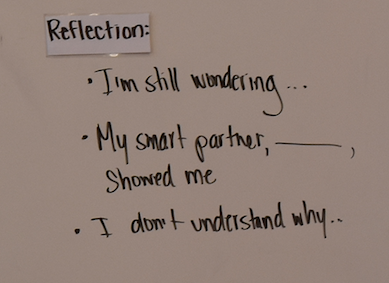This course for K-6 educators explores the power of student reflective journals in building students’ mathematical knowledge and practices.

Session 1: Explore the Inquiry Topic & Reflect on Your Current Practice
Outside-of-class meeting | Time: 1 hour | Materials: Recent Student Journals (class set) and board photographs for several recent lessons
Focus
Reflection allows students to get better at learning. We don’t learn from our mistakes; we learn from thinking about our mistakes. Through reflection, students become metacognitive–they learn to think about their own thinking, and so to build insights about the kinds of thinking that allow them to solve challenging mathematics problems, and the pitfalls to be avoided along the way
1A: Reflect on Your Current Practice
- Jot it down. What do you currently do to support your students to reflect on their work?
- Review your students’ journals. Do students routinely write about why they solved a problem in the way they did? Do they write about how their thinking changed, and what supported their change in thinking? Do they write about what they don’t understand, as well as what they have learned and how they came to learn it?
1B: Learn about New Strategies
Here are some strategies educators use to help students build the habit of reflecting on their learning:
- Reflection sentence stems, provided on a poster or inside cover of journal
- A class expectation not to erase mistakes, but instead to circle (or cross out) mistakes and to update thinking nearby, using a different color pen; older students can also explain why they made the mistake
- A class expectation that students will explain how and why their thinking changed–for example, naming the student whose thinking persuaded them, and why
- Sharing student journal entries to model high-quality reflection; these might include features like those just described or other features such as:
- Wondering about why something is true
- Noticing what makes a problem easy or hard
- Noticing connections or differences between different solution approaches
- Going beyond the class summary of learning to write about what was learned
Session 2: Try New Strategies in Your Classroom
In class | Time: 3-5 lessons over 1 to 2 weeks
- Note down the specific changes you will make over the next week (or next 3-5 lessons that use journals), in order to build your students’ capacity to reflect on their work
- Note down the evidence will you look for to gauge the impact of your work
- For the next week (or approximately 3-5 lessons in which journals are being used), try out the strategies that you identified to support your students to reflect on their work
- When possible, make notes after the lesson to capture your observations about the strategy that you tried
- Prepare for the next session by collecting your notes and your students’ journals
Session 3: Examine Evidence and Refine Your Plan
Outside-of-class meeting | Time: 30-60 minutes
3A: Examine Evidence from Lessons and Revise Plan
Examine student journal entries and read through any notes you jotted down as you were working to build students’ reflection on their mathematics learning.
Reflect on (or discuss) the following questions:
- What do you notice in students’ journals related to their reflection on their own mathematics learning? For example, what do you notice about the frequency and quality of reflection and the contexts that elicit it?
- What strategies were successful, and what did you find challenging, as you tried to build students’ habit of reflection on their learning?
- What strategies would you like to carry with you into your next week of instruction, and how would you like to modify these strategies to make them more beneficial for your students (if at all)?
- What new strategy would you like to test our in the next week?
Choose to work further on the strategy you have tried and/or to choose a new strategy, depending on what you think will have the greatest pay-off for your own learning and for your students.
3B: Make a Plan for Your Second Round
- What specific changes do you plan to make in your classroom use of journals to help support your students to reflect on their learning?
- What evidence will you look for to help you assess the impact of your work?
Session 4: Test Your Refined Approach
In class | Time: 3-5 lessons over 1 to 2 weeks
- Try out the strategies for approximately 3-5 lessons in which journals are being used (about 1-2 weeks)
- If possible, jot down notes during or soon after each lesson to capture your experiences with the strategies that you tried
- Bring your notes and your students’ journals to the next session
Session 5: Examine Evidence and Reflect on this Inquiry Cycle
Outside-of-class meeting | Time: 30-60 minutes
5A: Examine Student Journals, Read Notes, Reflect
Examine student journal entries and read through any notes you kept as you were working to build students’ reflection on their mathematics learning. Reflect on (or discuss) the following questions:- What do you notice in students’ journals related to their reflections?
- What strategies were useful as you worked to build your students’ mathematical reflection over the past 3-5 lessons?
- What challenges remain, with respect to building students reflection on their mathematics learning?
- What strategies would you like to carry with you into your future instruction, and how would you like to modify these strategies (if at all)?
- What new strategy(ies) would you like to try?
5B: Reflect on this Inquiry Cycle
- What did you learn that might inform future inquiries–for example, how to collect data, collaborate, find useful resources, etc.
- Is there anything from this inquiry you would like to share more broadly at your school or with the profession? How will you do this?


